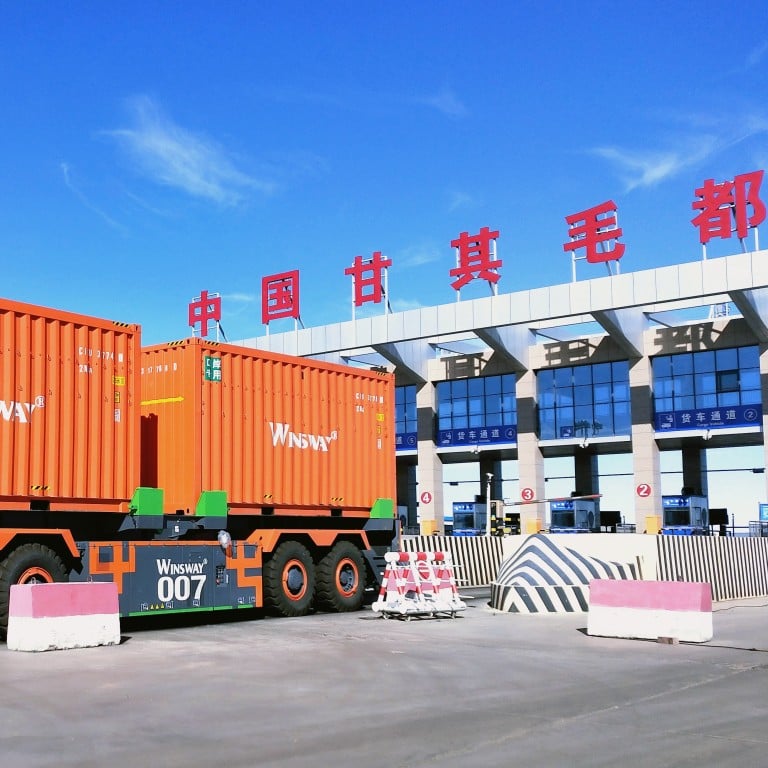
Resource-rich but underdeveloped Mongolia is planning seven new dry ports to expand trade with neighbouring giants China and Russia, a Mongolian official told the Post.
Authorities in the landlocked nation are conducting feasibility studies on the inland cargo ports, according to its minister of road and transport development, Sandag Byambatsogt, who added that the World Bank and United Nations Economic and Social Commission for Asia and the Pacific were working with Mongolia.
“I am confident that these initiatives will lead to the expansion of the Mongolian-Russian-Chinese economic corridor, resulting in increased export volumes and accelerated imports … and a reduction in the cost of transportation and goods,” Byambatsogt said.
At least one proposed port, in southeastern Mongolia’s Zamyn-Uud free economic zone, would operate near the Chinese border. And at least one other, in the northern Altanbulag free-trade zone, would be placed close to a crossing with Russia.
Mongolia needs new dry ports because its existing cargo and transport facilities lack the capacity to handle what has been a “surge” in exports, said Xu Tienchen, a senior China economist with The Economist Intelligence Unit in Beijing.
The surge followed improvements to other infrastructure, such as the completion of a road linking the giant Tavan Tolgoi coal mine to the Chinese border, and the start of 24-hour border crossings that are said to have begun in June.
Xu said the upgrades have eased shipment “bottlenecks” in Mongolia. Such projects do not require “hefty investments” but can produce “reasonable returns” if shipment volume is high, he said.
“These dry ports will not only serve the trade with these neighbours, but also countries that are farther away but are eager to tap into Mongolia’s mining reserves, such as France and Germany,” Xu said.
No estimated timetable for the ports’ completion was immediately available, and it was unclear how much the undertaking will cost.
Dry ports are land-based facilities that let shippers consolidate and distribute their goods, “resulting in value-added functions”, said TL Yip, an associate professor with Hong Kong Polytechnic University’s Department of Logistics and Maritime Studies.
Dry ports often connect by road or rail with a specific seaport to send marine cargo go farther inland.
“It is expected that China and Russia will welcome the new dry ports in Mongolia,” Yip said, adding that dry-port investors and developers could come from either China or Russia.
“Leveraging our strategic geographic location as the shortest route connecting Asia and Europe, Mongolia’s involvement in this corridor is pivotal,” Byambatsogt said.
The country of just 3.4 million people relies on China for numerous investments, while China sees Mongolia as a connector for trade with Central Asia.
China-Mongolia trade reached US$12.2 billion in 2022, according to Chinese customs data, up from US$9.1 billion the previous year. Minerals make up about 90 per cent of Mongolia’s exports, and China accounts for 80 per cent of all outbound shipments, according to UN figures.
Mongolian coal, for example, is used to power Chinese factories.
Byambatsogt anticipates that China-Mongolia trade will reach about US$20 billion a year in the “near future”.
The Mongolian government is also planning six new road projects to raise export capacity, Byambatsogt said.
It is expanding some of that network to support the Mongolia-Russia-China Economic Corridor in a bid to stoke trade among the three nations, while improving Mongolia’s access to land routes with Europe and with Asian countries that have seaports.
Byambatsogt said his country aims to create an “eastern railway corridor” as well. He said the railway will connect Russia, via Mongolia, to the Jinzhou and Lianyungang seaports in eastern China. From 2019 to 2023, he said, Mongolia added 905km (562 miles) of new railways, bringing its total network to 2,258km.
“The implementation of these projects is poised to enhance the competitiveness of transport and logistics not only within Mongolia but across the region,” the minister said.
News Related